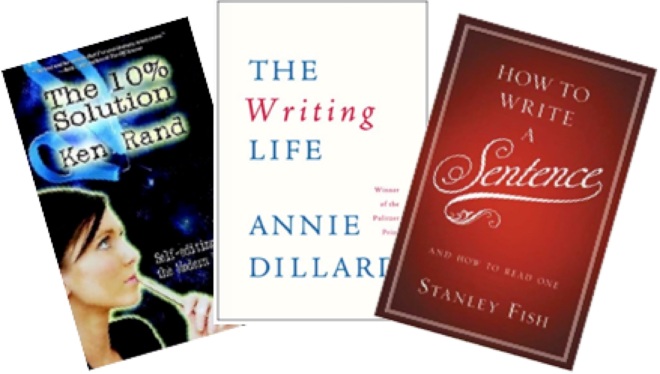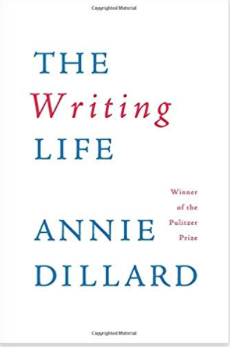You Can never Get enough Books on Writing
My mother collected cookbooks. From the Better Homes and Gardens classic to The Joy of Cooking to Southern Living, she loved browsing recipes. Me, I love poring over books about writing. Every title offers new tidbits that improve my craft (“The road to hell is paved with adverbs.”–King), motivate me (“Bird by bird, Buddy. Just take it bird by bird.”–Lamott), or just let me revel in the deliciousness of words (“The reader will usually find in the sentence some compensating merit, attained at the cost of the violation.”–White).
In a previous post, I recommended three must-have books on writing: The Elements of Style, by William Strunk, Jr. and E. B. White; On Writing, by Stephen King; and Bird by Bird, by Anne Lamott. Today I’m adding three more treasures to your chest that will make your writing kick ass!
Dedicate a bookshelf in your library (you have a library, right?) to books on writing.
The 10% Solution, by Ken Rand
Are you verbose? If your verbiage is more reminiscent of James Joyce than Ernest Hemingway, you may scare off today’s readers (Whom do you know who has read Ulysses?) despite your brilliance. Cutting out word garbage can make your writing clearer and easier for readers to navigate. Important concepts won’t get lost amid the clutter.
The 10% Solution offers a clever, easy method for cutting 10% of your text without losing meaning.
Put your writing on a diet. The 10% Solution is an editing tool you use to find and excise redundancies, bloated language, and unnecessary modifiers, trimming any text by 10%.
Did I say it was easy? This diet is. All you do is enter each of Ken Rand’s suspect syllables one at a time into your word processor’s search function. Start with -ly. Your search guru will highlight every -ly in your text, such as “She ran quickly.” Consider each highlighted word and ask: In the sentence, is it 1)accurate, 2) clear, and 3) brief? If you answer yes to all three, keep the word. If not, change it to something better or delete it. For our example sentence, replace ran quickly with a single action verb such as sped or darted. Now do the same with each syllable on Rand’s list.
That’s it! It takes a little while to go through the process the first few times, but soon you’ll discover which syllables you use like cheap cologne (my friend Michelle sprinkles that everywhere) and which stay locked in the drawer like fine perfume (she rarely uses very). Use the system faithfully, and you’ll find yourself avoiding Rand’s no-no’s as you write, saving yourself a step!
The 10% Solution is short and cheap and essential!
Remember what Mark Twain wrote in Tom Sawyer: “Writing is easy. All you have to do is cross out the wrong words.”
The Writing Life, by Annie Dillard
Whereas The 10% Solution is about applying a specific technique to improve your writing, The Writing Life is about constructing your mindset, your attitude, your purpose for writing. Consider it the spiritual Elements of Style. Dillard does not hit you over the head with instructions to do this or that. Instead, she offers what she does best–graceful stories that stroke the soul and serve as metaphors for each concept, occasionally followed by musings on how these play out for writers. In the process, the reader not only develops a writing philosophy, but one for life. Consider the poetry of this observation:
“A writer looking for subjects inquires not after what he loves best, but after what he alone loves at all. . . You were made and set here to give voice to this, your own astonishment.”
Another writing instructor might tell you to quit procrastinating and just do it–write! Instead, Dillard describes an inchworm stuck at the top of a blade of grass with nowhere else to climb. “Why don’t you just jump?” she tells it. “Put yourself out of your misery.”
Dillard uses other authors as examples, quoting Einstein, Wallace Stevens, Thoreau. . . . Words from Evelyn Underhill perfectly capture the motivating force of a writer:
“He goes because he must, as Galahad went towards the Grail: knowing that for those who can live it, this alone is life.”
I love, love, love this little book.
How to Write a Sentence: And How to Read One, by Stanley Fish
Just as a violinist needs to learn notes, scales, and vibrato, or a pilot needs to learn the cockpit instruments, a writer needs to learn sentence forms. The best way to do this, says Stanley Fish, is to examine gems from the world’s best wordsmiths. Figure out the relationships among the words–the syntax–and the meaning will take shape.
“I carry that sentence around with me as others might carry a precious gem or a fine Swiss watch. I pull it out and look at it. I pull it out and invite others (who are sometimes reluctant) to look at it. I put it under a microscope and examine its innermost workings.”
How to Write a Sentence is the writer’s How Things Work. In addition to exposing readers to masterful sentences, Fish offers exercises to help them understand how syntax informs meaning. For example, he uses the nonsense words in Lewis Carroll’s “Jaberwocky” to illustrate the importance of sentence structure.
Like Stanley Fish, I am a collector of sentences. After reading this book, I know why they are brilliant. Every day I use what I’ve learned to make my writing sing.
“Some appreciate fine art; others appreciate fine wines. I appreciate fine sentences. I am always on the lookout for sentences that take your breath away, for sentences that make you say, ‘Isn’t that something?’ or ‘What a sentence!'”
I’d love to know which writing books inspire you and make you more adept at our craft!




Brad Bird’s Secrets of Story is also good.
LikeLike
Ooh, I don’t know that one! Will check it out. Thanks for the tip!
LikeLike
Oh welcome. And thanks for mentioning that how to read a sentence book- I have it on the kindle but haven’t got round to having a look as yet.
LikeLike